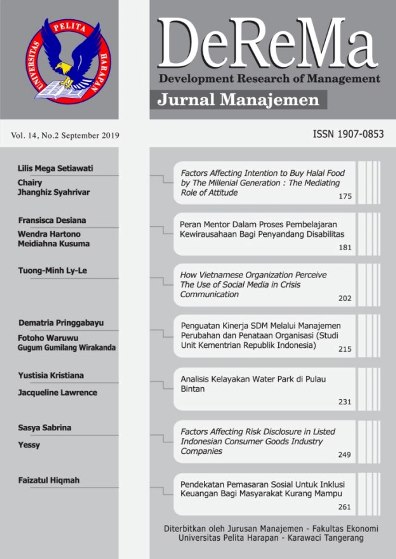Factors Affecting the Intention to Buy Halal Food by the Millennial Generation: The Mediating Role of Attitude
##plugins.pubIds.doi.readerDisplayName##:
https://doi.org/10.19166/derema.v14i2.1738关键词:
Religiosity, Halal Awareness, Halal Food, Purchase Intention, Millennial Generation摘要
The increasing Muslim population in recent years has resulted in an increased demand for halal food. This study aims to determine the effect of religiosity, awareness of halal food, and attitude towards halal food on purchase intention by millennial generations. This research is quantitative research with survey analysis method. The data used in this study is primary data using a questionnaire as a research instrument. The researchers surveyed 230 Muslim respondents of millennial age at President University. The sampling technique used in this study is judgment sampling method. Data analysis was performed using Partial Least Square-Structural Equation Model (PLS-SEM) software, namely SmartPLS version 3.2.8. The hypotheses were tested through path coefficient, t-Significance, p-Value, and determination coefficient (R²). Based on the results of this study, it is found that: 1) halal awareness has a significant effect on attitude towards halal food, 2) religiosity, halal awareness and attitude towards halal food each has a significant effect on purchase intention of halal food and finally, 3) halal awareness as mediated by attitude towards halal food has an effect on purchase intention of halal food. Whereas the relationship between religiosity and attitude towards halal food and the relationship between religiosity and purchase intention of halal food as mediated by attitude towards halal food cannot be supported. The result of this research is useful to predict the future of the halal industry in Muslim-majority countries. It is recommended that food marketers should consider these elements when producing and preparing marketing campaigns for halal foods.
Bahasa Indonesia Abstrak: Meningkatnya populasi Muslim akhir-akhir ini berakibat pada meningkatnya permintaan terhadap makanan halal. Studi ini dimaksudkan untuk mengetahui pengaruh religiositas, kesadaran terhadap makanan halal, dan sikap terhadap makanan halal, terhadap intensi membeli makanan halal di kalangan generasi milenial. Penelitian ini merupakan penelitian kuantitatif yang menggunakan metode survai. Data yang digunakan merupakan data primer yang diperoleh dengan menggunakan kuesioner sebagai instrumen penelitian. Sampel penelitian adalah 230 orang Muslim dari generasi milenial di President University. Teknik sampling yang digunakan adalah judgment sampling method. Analisis data dilakukan dengan menggunakan Partial Least Square-Structural Equation Model (PLS-SEM) software, yaitu SmartPLS version 3.2.8. Hipotesa penelitian diuji dengan melihat nilai koefisien jalur, nilai t, nilai p, dan koefisien determinsasi (R²). Berdasarkan hasil analisis data, ditemukan bahwa: 1) kesadaran halal mempengaruhi sikap terhadap makanan halal secara signifikan, 2) religiositas, kesadaran halal, dan sikap terhadap makanan halal, masing-masing memiliki pengaruh yang signifikan terhadap intensi membeli makanan halal, 3) sikap terhadap makanan halal memediasi pengaruh kesadaran halal terhadap intensi membeli makanan halal. Hasil penelitian juga memperlihatkan bahwa pengaruh religiositas atas sikap terhadap makanan halal tidak didukung data, demikian pula sikap terhadap makanan halal tidak memediasi pengaruh religiositas terhadap intensi membeli makanan halal. Hasil penelitian ini diharapkan bermanfaat untuk memperkirakan masa depan industri Halal di negara yang berpenduduk mayoritas Muslim. Para pemasar makanan perlu mempertimbangkan variabel yang digunakan dalam penelitian ini ketika menghasilkan dan mempersiapkan kampanye pemasaran untuk makanan halal.
参考
Abd Rahman, A., Asrarhaghighi, E., & Ab Rahman, S. (2015). Consumers and Halal cosmetic products: Knowledge, religiosity, attitude and intention. Journal of Islamic Marketing, 6(1), 148-163. https://doi.org/10.1108/jima-09-2013-0068
Afendi, N. A., Azizan, F. L., & Darami, A. I. (2014). Determinants of Halal purchase intention: Case in Perlis. International Journal of Business and Social Research, 4(5), 118-123.
Ahmad, N. A., Abaidah, T. N., & Yahya, M. H. A. (2013, March). A study on halal food awareness among Muslim customers in Klang Valley. In The 4th International Conference on Business and Economic Research (4th ICBER 2013) Proceeding (Vol. 1074).
Akter, S., Ambra, J., & Ray, P. (2011). An evaluation of PLS based complex models: The roles of power analysis, predictive relevance and GoF index. Research Online, 1-7.
Alam, S. S., & Sayuti, N. M. (2011). Applying the Theory of Planned (TPB) in food purchasing. Commerce and Management, 21(4), 8-20. https://doi.org/10.1108.10569211.
Ambali, A. R., & Bakar, A. N. (2014). People’s Awareness on Halal Foods and Products: Potential Issues for Policy-Makers. Procedia Social and Behavioral Sciences, 121, 3-25. https://doi.org/10.1016/j.sbspro.2014.01.1104.
Awan, H. M., Siddiquei, A. N., & Haider, Z. (2015). Factors Affecting Halal Purchase Intention - Evidence From Pakistan’s Halal Food Sector. Management Research Review, 38(6), 640-669. https://doi.org/10.1108/MRR-01-2014-0022.
Azam, A. (2016). An Empirical Study On Non-Muslim’s Packaged Halal Food Manufacturers: Saudi. Islamic Marketing, 7(25), 441-460. https://doi.org/10.1108/JIMA-12-2014-0084.
Aziz, Y. A., & Chok, N. V. (2013). The Role of Halal awareness, Halal certification, and Marketing Components in Determining Halal Purchase Intention Among Non-Muslims in Malaysia: A Structural Equation Modeling Approach. Journal of International Food & Agribusiness Marketing, 25(1), 1-23. https://dx.doi.org/10.1080/08974438.723997.
Bari, A., & Abbas, R. Z. (2011). Advertisement & Islam: A Muslim World Perspective. Business and Management Research, 1, 152-157.
Badan Pusat Statistik (BPS). (2010). Sensus Penduduk 2010. Downloaded from https://sp2010.bps.go.id/index.php/site/tabel?tid=321
Briliana, V., & Mursito, N. (2017). Exploring antecedents and consequences of Indonesian Muslim youths' attitude towards halal cosmetic products: A case study in Jakarta. Asia Pacific Management Review, 22(4), 176-184. https://doi.org/10.1016/j.apmrv.2017.07.012
Cornwall, M., Albrecht, S. L., Cunningham, P. H., & Pitcher, B. L. (1986). The dimensions of religiosity: A conceptual model with an empirical test. Review of Religious Research, 27(3), 226-244. https://doi.org/10.2307%2F3511418
Duffet, R. G. (2015). Facebook Advertising’s Influence On Intention-To-Purchase And Purchase Amongst Millenials. Internet Research, 25(4), 498-526. https://doi.org/10.1108/IntR-01-2014-0020.
Erdem, E., Varinli, I., & Yildiz, M. E. (2015). The Level of Consumers’ Awareness and Perceptions in Consumption of Halal Certified Products. Islamic Management and Business, 7(16), 65-75.
Farlina, B. R., Shafii, Z., & Shahwan, S. (2015). Awareness And Perception Of Muslim Consumers On Halal Cosmetics And Personal Care Products. Journal of Business, Economics and Management, 2(1), 1-14. https://doi.org/10.18488/journal.62/2015.2.1/62.1.1.14.
Garg, P., & Joshi, R. (2018). Purchase intention of “Halal” brands in India: the mediating effect of attitude. Islamic Marketing, 9(3), 683-694. https://doi.org/10.1108/JIMA-11-2017-0125.
Hasan, H. (2016). A Study On Awareness And Perception Towards Halal Foods Among Muslim Students In Kota Kinabalu, Sabah. Business and Social Sciences, 803-811.
Henseler, J., Hubona, G., & Ray, P. A. (2016). Using PLS path modeling in new technology research: updated guidelines. Industrial Management & Data Systems, 116(1), 2-20. https://doi.org/10.1108%2Fimds-09-2015-0382
Ibrahim, H., & Hashanah, I. (2015). A Generational Cohort Study of the Relationship between Religious Intensity and Religious Assurance for the Purchase of Non-food Products. Economics and Financial Issues, 330-334.
Jalil, N., Tawde, A., Sinclair, M., Fryer, C., Idrus, Z., & Philips, C. (2018). Attitudes of the public towards halal food and associated animal welfare issues in two countries with predominantly Muslim and non-Muslim populations. PLOS ONE, 13(10), 1-18. https://doi.org/10.1371%2Fjournal.pone.0204094
Kementrian Pemberdayaan Perempuan dan Perlindungan Anak (kemenpppa). (2018). Downloaded from https://www.kemenpppa.go.id/lib/uploads/list/9acde-buku-profil-generasi-milenia.pdf
Khalek, A. A. (2014). Young consumers’ attitude towards halal food outlets and associated animal welfare issues in two countries with predominantly Muslim and non-Muslim populations. Social Behavioral and Science, 121, 26-34. https://doi.org/10.1016/j.sbspro.2014.01.1105
Khanfar, M. N., Kaifi, A. B., & Kaifi, M. M. (2012). A Multi-Generational Workforce: Managing and Understanding Millennials. International Journal of Business and Management, 7(24), 88-93. https://doi.org/10.5539%2Fijbm.v7n24p88
Mainchum, K., Parichatnon, S., & Peng, K.-C. (2017). The Influence of Attitude, Knowledge and Quality on Purchase Intention towards Halal Food: A Case Study of Young Non-Muslim Consumers in Thailand. IRA-International Journal of Magement & Social Sciences, 6(3), 354-364. : http://dx.doi.org/10.21013/jmss.v6.n3.p3.
Majelis Ulama Indonesia (MUI). (Jan, 2019). Data sertifikasi Halal from LPPOM MUI Periode 2011 - 2018. Downloaded from http://www.halalmui.org/mui14/index.php/main/go_to_section/59/1368/page/1.
Muhammad, N., Leong, L. V., & Normalisa, I. M. (2017). Does the country of origin of a halal logo matter? The case of packaged food purchases. International Business and Strategy, 27(4), 484-500. https://doi.org/10.1108/RIBS-06-2017-0049.
Mukhtar, A., & Butt, M. M. (2012). Intention to choose Halal products: the role of religiosity. Journal of Islamic Marketing, 3(2), 108-120. https://doi.org/10.1108/17590831.
PewResearch. (April, 2019). The countries with the 10 largest Christian populations and the 10 largest Muslim populations. Downloaded from: https://www.pewresearch.org/fact-tank/2019/04/01/the-countries-with-the-10-largest-christian-populations-and-the-10-largest-muslim-populations/.
Sarwono, J., & Narimawati, U. (2015). Membuat Skripsi, Tesis dan Disertasi Dengan Partial Least Square SEM (PLS-SEM). Yogyakarta: ANDI.
Souiden, N., & Rani, M. (2015). Consumer attitudes and purchase intentions toward Islamic banks: the influence of religiosity. International Journal of Bank Marketing, 33(2), 143-161. https://doi.org/10.1108/ijbm-10-2013-0115
Stark, R., & Glock, C.Y. (1968). American piety: The nature of religious commitment. Berkeley: University of California Press.
Sugiyono. (2017). Metode Penelitian Kuantitatif Kualitatif dan R&D. Bandung: Alfabeta.
Syahrivar, J., & Azizah, P. A. (2018). The role of religiosity and brand perception in the brand preference for halal cosmetics: a case study of family-owned Islamic cosmetic business. International Journal of Technology Transfer and Commercialisation, 16(2), 146-158.
Rehman, A.-u., & Shabbir, M. S. (2010). The relationship between religiosity and new product adoption. Journal of Islamic Marketing, 1(1), 63-69. https://doi.org/10.1108/175908310.
Salleh, M. S. (2012). Religiosity in Development: A Theoretical Construct of an Islamic-Based. Humanities and Social Science, 266-274.
Soon, J., & Wallace, C. (2017). Application of theory of planned behaviour in purchasing intention and consumption of Halal food. Nutrition & Food Science, 47(5), 635-647. https://doi.org/10.1108/NFS-03-2017-0059.
Worldometers. (2019). Indonesia Population. Downloaded from: https://www.worldometers.info/world-population/indonesia-population/
##submission.downloads##
已出版
期
栏目
##submission.license##
Authors who publish with this journal agree to the following terms:
1) Authors retain copyright and grant the journal right of first publication with the work simultaneously licensed under a Creative Commons Attribution License (CC-BY-SA 4.0) that allows others to share the work with an acknowledgement of the work's authorship and initial publication in this journal.
2) Authors are able to enter into separate, additional contractual arrangements for the non-exclusive distribution of the journal's published version of the work (e.g., post it to an institutional repository or publish it in a book), with an acknowledgement of its initial publication in this journal.
3) Authors are permitted and encouraged to post their work online (e.g., in institutional repositories or on their website). The final published PDF should be used and bibliographic details that credit the publication in this journal should be included.





